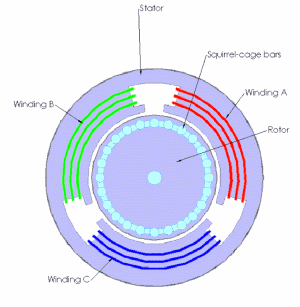Motors that convert electrical energy
to mechanical energy comprise two-thirds of the industrial demand
for electricity.
Most of these motors are
three-phase squirrel-cage induction motors which consist of an
arrangement of coils wound in slots in a stack of iron laminations
shown in cross section in figure 1 below. This part of the motor is
stationary and is called the stator. The coils in the stator are
connected in a manner to produce at least three separate windings
which are at angles of 120 degrees with respect to each other. This
is shown schematically in figure 1.

If a set of
three-phase voltages is applied to the windings shown, a magnetic
field will be produced in the center portion of the stator.
This magnetic field is constant in magnitude, and rotates at the
frequency of
the applied voltages (either 50
or 60 Hz depending on what country you're in).
|
The second part of
the motor (the rotor) is a set of round iron laminations that have
been attached to a shaft with bearings. There are slots in this set
of laminations as well. In this instance the slots are filled
with very low resistance bars of aluminum that are shorted together
at the outer edges of the laminated stack of iron. If the
rotor is inserted into the center part of the stator, the magnetic
field generated by the stator will cross through the shorting bars
of the rotor causing a large current in the rotor. These rotor
currents react with the magnetic field generated by the stator and
cause the rotor to spin. The rotor will continue to accelerate
until the shaft rotation speed is nearly equal to the velocity at
which the magnetic field of the stator is spinning.
The important point
here is that if the stator had only a single coil driven by a
single-phase voltage, then the magnetic field generated by the
stator would not rotate — it could for example point either up or
down, but not left or right. The motor could never start because
there would be no rotational component of the magnetic field.
Thus a three-phase system allows the mechanical energy being fed
into the generator to be transferred to three-phase induction motors
very efficiently. Three-phase motors also have the advantage of
being very simple and reliable--there are no electrical switches
contained in them. If they are not overheated, the only thing
that wears out is the bearings, which are replaceable.
|
|